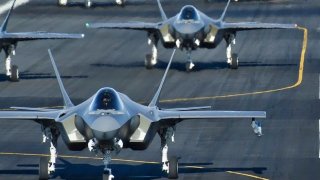After this Fix, the F-35's 25mm Cannon Is a Straight Shooter Once Again
The F-35A Lighting II stealth fighter jet can finally use its 25mm cannon as problems that hindered its proper operation have been solved, according to the F-35 program.
The F-35A Lighting II stealth fighter jet can finally use its 25mm cannon as problems that hindered its proper operation have been solved, according to the F-35 program.
F-35: Problem Solved
The F-35A’s GAU-22/A 25mm cannon had been suffering from issues, resulting in an inability to shoot straight. Understandably, this serious problem caused concerns about the ability of the military’s most advanced fighter jet to perform in actual combat conditions.
A spokesperson from the F-35 Joint Program Office told the Drive’s War Zone that issues plaguing the GAU-22/A 25mm cannon have been solved.
“After working with the Air Force and our industry partners we can report that the gun has been improved and is effective,” Russ Goemaere, the F-35 Joint Program Office spokesperson, said in a statement.
The GAU-22/A is a four-barreled Gattling cannon that can fire an astounding 3,300 rounds per minute.
To be sure, if an F-35A has to use its gun in a dogfight with an enemy fighter jet something has gone wrong. The stealth aircraft is equipped with sensors and munitions to take out adversaries at long ranges, before they ever come close.
“We continue to work with industry, the Services, and our international partners for further improvements and to maximize effectiveness and lethality at the tactical/operational level,” Goemaere added.
The F-35A is a stealth aircraft. As such, its 25mm cannon is imbedded within the airframe and the barrel doesn’t protrude. Specifically, the gun is situated on the left side of the aircraft, just above the left engine.
The F-35 Lighting II
As the most advanced fighter jet in the world, the three versions of the F-35 Lighting II bring unmatched capabilities on the battlefield.
Through the fifth-generation stealth fighter jet, the Department of Defense wanted an aircraft that would concentrate several different mission sets into one platform, thus streamlining production and follow-on support and reducing maintenance costs across the services. As a result, the F-35 Lighting II can competently conduct six main mission sets: Strategic Attack; Air Superiority; Close Air Support, Electronic Warfare; Intelligence, Surveillance, and Reconnaissance (ISR); Suppression of Enemy Air Defenses (SEAD); and Destruction Enemy Air Defense (DEAD).
The three versions of the stealth fighter jet are the F-35A, F-35B, and F-35C. Although essentially the same aircraft, each version is slightly different than the rest.
The F-35A is the standard version that takes off and lands from runways. Used by the Air Force, this is the most numerous iteration of the stealth fighter jet.
The F-35B is the Short Take-off, Vertical Landing (STOVL) iteration of the stealth fighter jet. As a STOVL aircraft, the F-35B can take off and land like a helicopter in small surfaces. This gives it a great advantage in expeditionary operations. The Marine Corps and a few foreign partners use the F-35B.
Finally, the F-35C is the carrier version of the aircraft and has a stronger structure and landing gear so it can land on aircraft carriers. This version can also carry more fuel than the other two due to its mission.
About the Author
Stavros Atlamazoglou is a seasoned defense and national security journalist specializing in special operations. A Hellenic Army veteran (national service with the 575th Marine Battalion and Army HQ), he holds a BA from the Johns Hopkins University, an MA from the Johns Hopkins’ School of Advanced International Studies (SAIS). He is pursuing a J.D. at Boston College Law School. His work has been featured in Business Insider, Sandboxx, and SOFREP.


